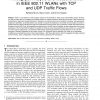Free Online Productivity Tools
i2Speak
i2Symbol
i2OCR
iTex2Img
iWeb2Print
iWeb2Shot
i2Type
iPdf2Split
iPdf2Merge
i2Bopomofo
i2Arabic
i2Style
i2Image
i2PDF
iLatex2Rtf
Sci2ools
TMC
2008
2008
Throughput Analysis and Measurements in IEEE 802.11 WLANs with TCP and UDP Traffic Flows
There is a vast literature on the throughput analysis of the IEEE 802.11 media access control (MAC) protocol. However, very little has been done on investigating the interplay between the collision avoidance mechanisms of the 802.11 MAC protocol and the dynamics of upper layer transport protocols. In this paper, we tackle this issue from an analytical, simulative, and experimental perspective. Specifically, we develop Markov chain models to compute the distribution of the number of active stations in an 802.11 wireless local area network (WLAN) when long-lived Transmission Control Protocol (TCP) connections compete with finite-load User Datagram Protocol (UDP) flows. By embedding these distributions in the MAC protocol modeling, we derive approximate but accurate expressions of the TCP and UDP throughput. We validate the model accuracy through performance tests carried out in a real WLAN for a wide range of configurations. Our analytical model and the supporting experimental outcomes s...
| Added | 15 Dec 2010 |
| Updated | 15 Dec 2010 |
| Type | Journal |
| Year | 2008 |
| Where | TMC |
| Authors | Raffaele Bruno, Marco Conti, Enrico Gregori |
Comments (0)

